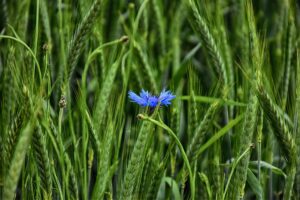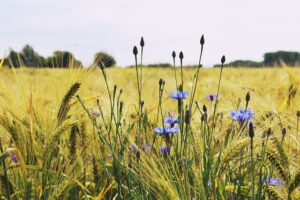The blue cornflower or the bachelor button, botanically known as the Centaurea cyanus is from, the family Asteraceae. Boutonniere flower, bluebonnet, blue cup and, hurt sickle are other popular names for the same flower. The behind story of the flower is as much as beautiful and graceful.
Did you know?
The Once a wildflower, now is a national symbol of Germany?
Other than its herbal and symbolical values, the plant is now a glittering star among the gardeners.
What is blue cornflower?
The annual plant is an undeniable beauty with growing up to a 40–90 cm height. The catchy blue color flowers arrange into a flowerhead of about 3cm. The radiant blue color is due to Protocyanin. The plant gives flowers throughout the summer and produces small fruits. The resulting seeds can attract birds.

Where do cornflowers grow best?
The flower often grew as a weed in cornfields in the past. Therefore, people call it blue cornflower. From its origin, the plant is native to Europe. But now you can find it outside Europe, including North America and Australia.
What is blue cornflower good for?
The blue cornflowers are beneficial from our day-to-day life to specific needs. Here are a few applications of blue cornflowers.
- A food
The blue cornflower can be consumed in fresh, dried, or cooked forms. Petals go well in salads, drinks, and dessert garnishing.
- Herbal medicine
All parts of the plant have differential, medicinal uses. The blue cornflower is an excellent source of antioxidants, flavonoids, and aromatic compounds.
The flower can be used to treat fever, constipation, water retention, and chest congestion. It is a good stimulator for the liver and gallbladder. Females use blue cornflowers to reduce menstrual complications. It is also used in eye irritations and is a component in eye drops and eye lotions.
- Cosmetic uses
The blue cornflower has effective natural remedies, anti-inflammatory, and relaxing properties. It fights against the dark circles around the eyes and helps decongest the eyes. You can use them as a remedy for acne as well.
- Tea
The dried petals are often used as tea. So, there comes an obvious question.
What does Blue cornflower tea taste like?
This is a tricky question. If you are a tea lover, you already know that the flavor depends on several factors. The same goes for the blue cornflower tea. The flowers contain anthocyanin, other flavonoids, and bitter-causing substances. However, it is free from harmful substances. So the flavor is a combination of them. But as a remarkable characteristic, it has a floral-bitter taste. Surprisingly, a blue cornflower tea product can be stored for about 24 months from the production date.

- Colour pigments
The flower’s rich blue color is the result of Protocyanin, and Anthocyanin pigment. Blue cornflower-derived natural colors are used as food additives in various products.
- Ornamental plant
The outstanding and beautiful appearance of the flower is famous among ornamental plant enthusiasts. You can choose a color from blue, white, purple, pink, or even black petals.
- Phytoremediation
The blue cornflower can effectively treat soils with lead contaminations. The plant absorbs lead and reduces its availability in soil.
Growing a blue cornflower plant in your garden
If you plan to have cornflowers in your garden, there is not much reason to hesitate. Once you plant them in a bed, they will thrive under suitable environmental conditions.
Do cornflowers come back every year?
The answer is YES.
They can self-seed and will produce flowers every year.
What is the best place to plant a blue cornflower plant?
- The plant prefers open fields with light.
- Moist but well-drained soils will support the plant growth
- It’s better to maintain a distance of 8-12 inches in between plants.
- A well-established plant can withstand drought. However, an adequate amount of water is helpful in plant growth.
- Unlike the delicate flowers, the plant with light freezes and steamy summer days.
- You can apply fertilizer during the early spring. It is better to apply fertilizer once a month. A liquid manure or compost tea will enhance your plant growth. A balanced fertilizer formula or one with rich phosphorus content can boost the flowering.
- The blue cornflower plant doesn’t have many pest and disease problems and, is easy to look after. But maintaining the proper space helps to reduce aphid and leafhopper problems.
How do you plant blue cornflower seeds?
The easiest method to grow new plants is from seeds. You can sow the seeds from early to mid-spring. So, it will be rewarding in the summer. The mild winter is the best for upcoming seedlings. The blue cornflower seeds will thrive in soil or containers. But, make sure that the seeds are about 2 inches apart and one-half inch buried.
It is amazing how once a disregarded wild floret has evolved into carrying such cultural, political and environmental importance. In some countries, it is a representation of love, war, and many other things. Unfortunately, this glamour is now only confined to gardens because of the excessive use of Agrochemicals. However, you still have the chance to experience the charm of blue cornflower. Plant them among other ornamental plants to discover the contrasting and alluring blue color.



